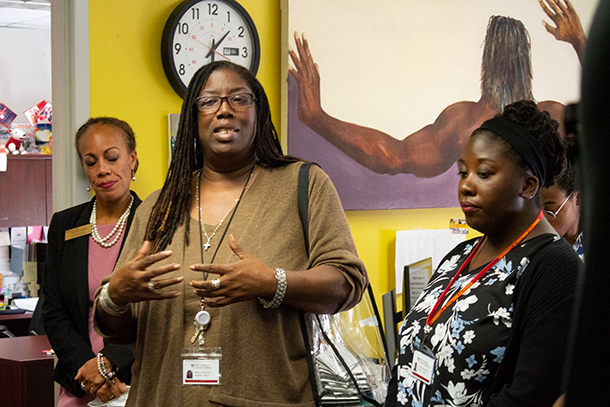Since the second-wave feminist movement of the 1960s, ’70s and ’80s to the debate over reproductive rights and the global phenomenon of #MeToo, a number of social and political factors have brought increased attention to issues of sexual violence and assault. Unfortunately, the problem endures: Today, it is estimated that 1 in 6 American women and about 3% of American men have been the victim of an attempted or completed rape.
“Though by no means a comprehensive answer to the problem of assault, creating clearer parameters to the definition of consent can help move the needle on the larger mission of eliminating sexual violence,” said Brenda Ingram, EdD, director of Relationship and Sexual Violence Prevention and Services at USC Student Health.
Ingram, who is also a clinical assistant professor of psychiatry and the behavioral sciences at the Keck School of Medicine of USC, shed light on what affirmative consent is, what is being done about it at USC and why it should be made a legal standard in all states.
Understanding affirmative consent
Nearly half of U.S. states and territories do not have explicit legal definitions of consent, creating legal ambiguity that often impedes the effective prosecution of sexual assault and rape cases. Even in states and territories that do have clear statutory definitions of consent, such as California, there is rarely a standardized measure of how consent is given or what consent legally permits.
“The purpose of affirmative consent laws is to ensure that every participant is providing authentic, uncoerced, ongoing, voluntary permission to proceed at every step in a given sexual encounter,” Ingram said. “Though not all affirmative consent laws require verbal affirmation, the overarching idea is to shift the legal narrative from ‘no means no’ to ‘yes means yes.’ ”
Addressing gray areas
Even with affirmative consent laws in place, other factors can complicate the consensuality of a sexual encounter. Perhaps the most common example concerns consenting while intoxicated.
“When a person is under the influence of a judgement-impairing substance, they are less likely to be able to give fully informed and uncoerced consent,” Ingram said. “It is incumbent upon the person asking for consent to receive conscious and informed affirmation in order to proceed.”
As with those who are heavily intoxicated, people who are unconscious or asleep can never give consent. Further, if a participant in a sexual encounter has a mental disability, even verbal consent may not amount to true affirmative consent.
Ingram explained that since cognitive capacity varies, seeking consent from a person with a mental disability can be legally and ethically unclear: “A person with one mental condition may be able to reasonably provide informed consent while another person with a more severe case of the same condition may be unable to do so.”
Ingram stressed that “consent is never a blanket statement,” meaning that consenting to one sexual act does not equate to consent for additional sexual acts, even within the same encounter.
“Consent can be retracted at any time,” she said. “This is why it’s critical to check in with your partner or partners every step of the way and continually assess whether they are able to provide rational, genuine consent.”
Promoting safety and consent at USC
At USC, Ingram is working to shift the rhetoric used to discuss sexual violence to focus less on retroactive anti-violence and more on promoting safety through proactive measures.
She spearheaded an initiative called Trojans Respect Consent, a program of USC Student Health, that requires all incoming undergraduate students to participate in a 90-minute workshop on affirmative consent. The workshop centers on practicing how to engage in conversations about sexual activity with other students.
“A lot of incoming students are still teenagers with little experience having explicit, frank conversations about sex,” said Sarah Hong, MPH, a USC Student Health sexual violence prevention specialist working on the consent program with Ingram. “Even more don’t know how to handle rejection. We want to help them develop a set of useful communication skills that enable them to feel more confident discussing consent so that misunderstandings are avoided.”
Relationship and Sexual Violence Prevention and Services also offers healthy relationship workshops, available free of charge to all students. Those workshops are focused on building mutual respect and effective communication skills in an effort to reduce intimate partner violence.
Ingram is developing a prosocial bystander curriculum for USC students for observers to actively intervene to stop an instance of harassment, violence or assault. Bystander intervention is particularly important on college campuses, Ingram said, as college-aged women are at increased risk for sexual violence.
“Though most assaults occur in private settings, there are often witnesses to pre-assault behaviors — which may include intimidation, threatening, harassing or stalking,” she said.
According to the 2015 AAU Campus Climate Survey on Sexual Assault and Sexual Misconduct, a survey administered to students at universities across the country, nearly 20% of students say they have witnessed someone acting in a sexually violent or harassing manner. Yet, of these bystanders, more than half admit they did nothing to intervene, with a quarter saying they weren’t sure what to do and 30% saying they did not act for some other reason.
Ingram is committed to creating change through awareness-building and preventive interventions at the local level, while acknowledging that combatting sexual violence and assault requires systemic change driven by policymakers, educators, community activists and more.
“We can’t fix rape culture overnight, but through violence-prevention initiatives like those at USC, we can cultivate a greater sense of empathy and communal responsibility for one another’s safety,” she said.
“If all of us possess the operational skills to have honest, open conversations and step in when we see something that’s not right, we can reduce rates of sexual harassment and violence on campus and in the broader community.”


